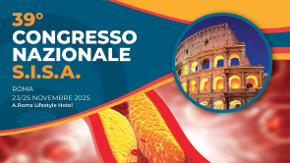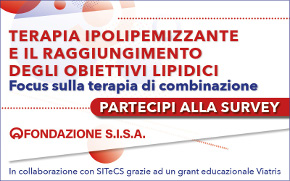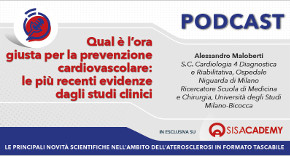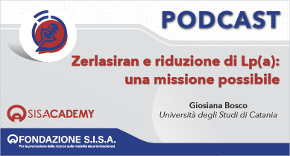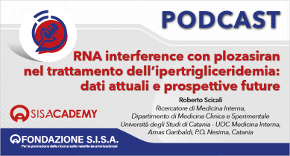 Rivista in lingua italiana
Rivista in lingua italiana
riservata ai Soci SISA
Ultimo numero:
Anno 16 • N.1/2025
SISANews
La randomizzazione mendeliana per la valutazione del peso dei fattori di rischio
Sono numerosi i biomarcatori che sono stati trovati associati alle malattie cardiovascolari e per molti di essi è incerto il ruolo causativo. Diversamente dallo studio dei fenotipi, quello del genoma e delle sue varianti aiuta a discriminare i fattori influenti da quelli confondenti che sono associati alla malattia senza però esserne causa. Sono molti i biomarcatori sottoposti ad analisi e secondo il modello della randomizzazione mendeliana solo il colesterolo LDL, l'ipertensione arteriosa e probabilmente la lipoproteina (a) e l'interleuchina 6 sono associati causalmente alla malattia cardiovascolare, mentre colesterolo HDL e proteina C reattiva, tanto per citare i più noti, non lo sono. Rimangono dubbi per il diabete e l'obesità.
![]()
Mendelian randomization studies in coronary artery disease.
Jansen H, Samani NJ, Schunkert H
Eur Heart J 2014;35:1917-1924
Epidemiological research over the last 50 years has discovered a plethora of biomarkers (including molecules, traits or other diseases) that associate with coronary artery disease (CAD) risk. Even the strongest association detected in such observational research precludes drawing conclusions about the causality underlying the relationship between biomarker and disease. Mendelian randomization (MR) studies can shed light on the causality of associations, i.e whether, on the one hand, the biomarker contributes to the development of disease or, on the other hand, the observed association is confounded by unrecognized exogenous factors or due to reverse causation, i.e. due to the fact that prevalent disease affects the level of the biomarker. However, conclusions from a MR study are based on a number of important assumptions. A prerequisite for such studies is that the genetic variant employed affects significantly the biomarker under investigation but has no effect on other phenotypes that might confound the association between the biomarker and disease. If this biomarker is a true causal risk factor for CAD, genotypes of the variant should associate with CAD risk in the direction predicted by the association of the biomarker with CAD. Given a random distribution of exogenous factors in individuals carrying respective genotypes, groups represented by the genotypes are highly similar except for the biomarker of interest. Thus, the genetic variant converts into an unconfounded surrogate of the respective biomarker. This scenario is nicely exemplified for LDL cholesterol. Almost every genotype found to increase LDL cholesterol level by a sufficient amount has also been found to increase CAD risk. Pending a number of conditions that needed to be fulfilled by the genetic variant under investigation (e.g. no pleiotropic effects) and the experimental set-up of the study, LDL cholesterol can be assumed to act as the functional component that links genotypes and CAD risk and, more importantly, it can be assumed that any modulation of LDL cholesterol-by whatever mechanism-would have similar effects on disease risk. Therefore, MR analysis has tremendous potential for identifying therapeutic targets that are likely to be causal for CAD. This review article discusses the opportunities and challenges of MR studies for CAD, highlighting several examples that involved multiple biomarkers, including various lipid and inflammation traits as well as hypertension, diabetes mellitus, and obesity.

Area Soci
Eventi
39° Congresso Nazionale
 39° Congresso Nazionale
39° Congresso NazionaleRoma, 23-25 novembre 2025
Save the date




 Spring Meeting Gruppi Giovani SID, SIGG, SIIA, SIMI, SIPREC, SISA
Spring Meeting Gruppi Giovani SID, SIGG, SIIA, SIMI, SIPREC, SISARimini, 6-8 aprile 2025
[continua a leggere]
 SISA LIPID ACADEMY - Corso avanzato di lipidologia clinica
SISA LIPID ACADEMY - Corso avanzato di lipidologia clinicaModena, 4-5 Luglio 2024
[continua a leggere]Giornale Italiano Arteriosclerosi
HoFH today
 Rivista Italiana della
Rivista Italiana della
Ipercolesterolemia
Familiare Omozigote
Anno 6 • N.1/2024
Rivista NMCD
Diateca
[continua a leggere]
[continua a leggere]
Newsletter
il vostro indirizzo di posta elettronica
Progetto LIPIGEN

Nuovo sito dedicato al Progetto LIPIGEN
Progetto LIPIGEN - Vecchio portale
E' necessario essere loggati come utente
Lipigen per poter accedere alla pagina
PROject Statin Intolerance SISA
PROSISA – PROject Statin Intolerance SISA
E' necessario essere loggati come utente
PROSISA per poter accedere alla pagina
GILA - Lipoprotein Aferesi
Gruppo Interdisciplinare Lipoprotein Aferesi
(Accesso Gruppo GILA-Lipoprotein Aferesi)
E' necessario essere loggati come utente del Gruppo GILA per poter accedere
Gruppo Interdisciplinare Lipoprotein Aferesi
(Documentazione ad accesso libero)
Pagina informativa per medici e pazienti


